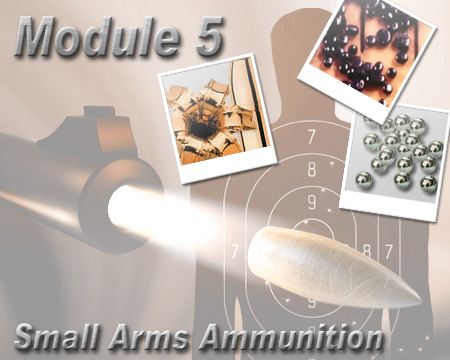Home | Glossary | Resources | Help | Contact Us | Course Map
Archival Notice
This is an archive page that is no longer being updated. It may contain outdated information and links may no longer function as originally intended.
| Author: J. Allan Jones |
| J. Allan Jones obtained a Bachelor of Science degree (1969) from Southern Methodist University and continued graduate studies there until 1971, when he joined the Dallas County (Texas) Institute of Forensic Sciences Crime Laboratory as a firearm examiner. Mr. Jones worked in that capacity until 1987, when he moved to Lewiston, Idaho, as the manager of technical publications for CCI Ammunition and Speer Bullets. He directed ballistics research for and authored Speer Reloading Manual, numbers 12, 13, and 14. Mr. Jones retired from CCI/Speer in 2007. |
Introduction
This module primarily covers the development and manufacture of small arms ammunition. Both old and new technologies are reviewed. In addition, the basic principles of handloading and reloading ammunition are addressed, referencing the tools and dies which can leave class and individual toolmarks on the surfaces of cartridges.
Small arms ammunition manufacturing technologies are important to the firearm examiner because this is an area where class characteristics are produced. This should not be confused with the class and individual characteristics that may be produced by the operation of a firearm.
Before discussing how ammunition is made, we will review some basic nomenclature used in ammunition and its manufacturing operations.
Objectives
At the conclusion of this module, the student should be able to
- describe the components of ammunition,
- describe the historical development of propellants, both single and double based,
- describe projectile manufacture methods,
- define bullet jacket types and materials,
- describe jacket manufacture technologies,
- describe the steps in cartridge case manufacture,
- describe the shotshell manufacture process,
- describe the primer manufacture process,
- differentiate between the primer manufacture process for rimfire and centerfire cartridges,
- differentiate between shotshell and cartridge primer manufacture,
- describe the steps in the ammunition assembly process,
- describe the steps in ballistic testing,
- describe the steps in the shotshell assembly process,
- describe the reloading process and how it can be used for firearm identification.
AFTE Knowledge and Ability Factors
| 85. | Knowledge of propellants: physical forms and associated purposes of small arms propellants; black gun powder and Pyrodex; nitrocellulose propellants, both single and double base |
| 86. | Knowledge of projectiles: design (ogive shape, base shape, cannelure types, forming processes); construction and composition (lead alloy compositions, jacketing materials and styles, etc.) |
| 87. | Cartridge cases: design (i.e., rimfire, centerfire, Boxer/Berdan priming systems); compositions (copper, brass, steel, aluminum) |
| 88. | Manufacturer information: headstamps, color coding |
| 90. | Knowledge of shotshell: design, construction and nomenclature; shot sizes and composition (hardened lead, plated steel, etc.); wad design and types of filler (buffering) materials |
| 91. | Knowledge of primers: design, color, staking |
| 92. | Knowledge of ammunition components |
| 93. | Knowledge of ammunition manufacturing methods |
| 95. | Knowledge of the principles of ammunition reloading |
| 96. | Knowledge of the tools, sources, and types of components used in ammunition reloading, and when to use them |
| 115. | Knowledge of the toolmarks created during the reloading of ammunition |
| 39. | Ability to recognize, compare and identify various ammunition types and components |
| 43. | Ability to recognize reloaded or handloaded ammunition |
| 46. | Ability to recognize: (1) those attributes or characteristics of a particular firearm design which are reflected in the fired projectiles and fired cartridge cases; and (2) nonfirearm caused toolmarks on ammunition components |
| 47. | Ability to determine the source and uniqueness of various striated and/or static marks on bullets and cartridges |
| 77. | Ability to identify the physical form and type of small arms propellant recovered from a gun, victim's clothing, etc. (e.g., flattened ball powder, perforated disc, flake powder, etc.) |
| 82. | Ability to recognize the various physical and chemical forms of propellants, their purpose in various cartridges, and their value as physical evidence |
Additional Online Courses
- What Every First Responding Officer Should Know About DNA Evidence
- Collecting DNA Evidence at Property Crime Scenes
- DNA – A Prosecutor’s Practice Notebook
- Crime Scene and DNA Basics
- Laboratory Safety Programs
- DNA Amplification
- Population Genetics and Statistics
- Non-STR DNA Markers: SNPs, Y-STRs, LCN and mtDNA
- Firearms Examiner Training
- Forensic DNA Education for Law Enforcement Decisionmakers
- What Every Investigator and Evidence Technician Should Know About DNA Evidence
- Principles of Forensic DNA for Officers of the Court
- Law 101: Legal Guide for the Forensic Expert
- Laboratory Orientation and Testing of Body Fluids and Tissues
- DNA Extraction and Quantitation
- STR Data Analysis and Interpretation
- Communication Skills, Report Writing, and Courtroom Testimony
- Español for Law Enforcement
- Amplified DNA Product Separation for Forensic Analysts



